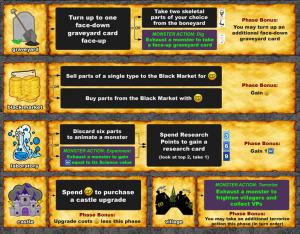This reference card provides a quick overview of the five phases in Monster Graveyard.
Category Archives: Rules
Rules – Laboratory Phase
0Here is an exerpt from the rulebook that covers rules for the Laboratory Phase.
Phase Summary
- Reanimate: Discard six body parts to reanimate a monster
OR - Experiment: Exhaust a monster to gain research points
- Acquire Research Cards by spending research points
Laboratory Actions
Reanimate
The reanimate action is used to create new monsters to do your bidding. The attributes of your newly animated monster are determined by the body parts used and by any research upgrades you may have.
- Note: Skeletal parts are always returned to the Boneyard when discarded; all other parts go to the Graveyard discard pile.
- Every monster starts with base attributes of 1 Terror, 1 Science, and 1 Health.
- Apply bonuses from each standard part (fresh, rotting, or putrefied) discarded. Each standard part increases the monster’s attribute by 1. Skeletal parts don’t provide any bonuses.
- Apply bonuses from any special parts discarded.
- Apply bonuses from any research upgrades you own.
- Some special parts may also grant an ability to the new monster. These cards are marked with a star indicator (☆). For each such part used when reanimating a monster, find the corresponding reminder token and place it on the monster. There is no limit to the number of abilities that a monster can acquire in this way.
- Other special parts may provide a non-attribute bonus, such as GP, when used to reanimate a monster. Several research upgrades also provide this kind of bonus. Score these bonuses immediately after taking a reanimate action.
|
Example 1
Example 2
Example 3
|
Experiment (monster action)
Acquire Research Cards
There are three research decks, each with an associated RP cost: 3RP, 6RP, and 9RP. Cards in higher-cost decks provide substantial bonuses over those that cost less.
To acquire a research card:
- Select a research deck: 3, 6, or 9.
- Spend the corresponding amount of RP. Return those points to the supply.
- Look at the top two cards of the selected deck. Choose one of the cards to play, and place the other on the bottom of the deck. You do not need to reveal the card which you put on the bottom.
- Play the card you selected. If it’s a research upgrade (blue card), place it in the play area in front of you. If it’s a discovery (yellow card), follow the instructions on the card, then put it in the discard pile for that research deck.
Types of Research Cards
There are two types of research cards: research upgrades and discoveries.
Research upgrades (blue) provide bonuses when you reanimate monsters. Most upgrades grant attribute bonuses to monsters when you reanimate them; others provide different bonuses, such as drawing parts from the oneyard. Upgrades don’t grant bonuses to your existing monsters.
Discoveries (yellow) provide an immediate bonus, then are discarded. These bonuses may grant you additional gold, victory points, or research points, or might provide you with a different benefit, such as extra body parts or a boost to one of your monsters.
Players can never possess two or more research upgrades that provide a bonus to the same attribute. If you play an upgrade that give a bonus to the same attribute as another upgrade you have, you must discard one of the upgrades immediately.
|
Example
|
